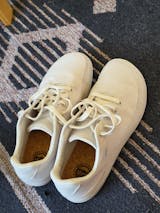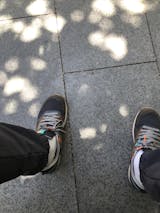
Seleisa Duddy Podiatrist and Movement Therapist [CPT-Restorative Exercise Specialist]
Feet are our connection to the earth and our first mode of transport. When foot pain occurs, both our gait pattern and connections are altered. The “painful” problem often has its “victim” feeling unhappy and frustrated, coupled with the negative effects on mobility and function.
A research article (Ref 1) has found that 1 in 4 older adults over the age of 65 years suffer from some form of foot pain. These adults had the perspective that foot pain was considered part of the “normal” ageing process and were willing to “put up with the pain” because this was natural progression of getting older. (Ref 2)
Take note: THIS IS A FALSE BELIEF!
Unfortunately, assistance and treatment can be delayed due to this false belief, and these adults may have endured pain and discomfort unnecessarily.
The ageing process begins at birth and continues until the end of our lives. Perhaps a helpful perspective regarding foot pain would be to view pain as a gift to inform us that something is wrong within a body system, or that there may be an environmental influence causing it.
So the question to ask, ponder and investigate is -
“Is there an action I am doing that could possibly be the cause of my foot pain? If so, what is the action?”
Possible answers may be:
-
Trauma (dropped the frozen chook while getting it out of the freezer)
-
Kicked my toe on the bed leg while making the bed
-
The trolley wheel ‘attacked my toes’
-
ill-fitting shoes I wear (or used to wear)
-
Arthritis, gout, neuropathy
-
Medication side effects
-
chemotherapy
-
poor circulation
-
poor feet alignment
-
body mechanics and weight distribution
…and more.
There are many causes of foot pain, but each belongs in one of two categories:
1. Mechanical force — overweight, footwear, trauma, gait pattern
2. Biological cause — like diabetes, neurological disorders, arthritis, gout or vascular disease
The most common cause of preventable foot pain is… SHOES!!!

Society’s desire for fashionable, good looking shoes is strong and has existed for many centuries. It has superseded the logic which is: “our feet should wear shoes that match the shape of our foot, allowing for effective feet biomechanics.”
Shoes can either give you the confidence and ability to walk and dance all day everyday, or cripple you with pain and dysfunction, reducing your capacity to be productively active.
In 2017, the largest footwear market with a revenue of $79.86 billion is the United States, followed by China with 58.31 billion. However, in terms of production, China approximately produced 13.1 billion pairs of shoes. (Ref 3)
With the amount of money being spent on footwear, one would hope that footwear designers and manufacturers are considering the anatomy of the foot and designing shoes that support good foot health.
Function over fashion, right? But who I am kidding!!!
As I scan another shoe store in my quest for a functional shoe to recommend to my clients, I walk away disappointed yet again. Fortunately there are a good number of footwear companies whose shoes support the design of the healthy human foot, if you know where to look. I’ve listed some at the end of this article.
If you haven’t looked at the anatomy of the foot recently, search out some images and be prepared to be blown away by some truly incredible engineering! I hope you became impressed enough to decide to take action by looking and buying better footwear that actually matches the shape of your amazing feet.

You may have noticed a gentle but growing movement toward more minimalistic footwear . There are healthier footwear options more readily available that have the focus on natural human foot function over looks! This is positive news for us all who really care about the future health and function of our feet. We desire to have our feet maintain their connection to the earth, to engage more with their environment and to be actively promote of healthy foot function with every step. In doing so, foot pain problems can be prevented and normal human function maintained or restored in time with exercises, healthy shoes and commitment.
So what do you look for?
I have broken it down into an acronym—
HUTS HEEL: Under the ankle/heel part of the foot
UPPER: Top section of the shoe
TOEBOX: Toe area
SOLE: Entire bottom part of the shoe
Here is a simple table to use as a guide. You want to be able to answer YES to each of these questions:
When you go shopping for shoes, remember HUTS and you will become an informed consumer to buy better “HUTS” for your feet to live in! Foot deformity—or lack of deformity—tells the story of the environment we have applied to our feet throughout our lives.
• Are the fleshy pads under our toes in contact with the ground, or is it the nail?
• Is the ability to spread our toes still active or is there little to no spreading at all?
• Are your toes straight or do the overlap or clawed?

Knowing what features to look for in a healthy shoe will help to prevent future foot problems, and could even manage or eliminate that painful problem you’re experiencing right now. Commencing good healthy foot care habits as early as possible will provide the freedom of independence to move and walk around pain free, enjoying the benefits of functional feet. If you want to remain independent in your later years and be able to move around pain free, adding to your understanding of feet and their function is a great place to start. Then continue by practicing good foot-health habits, for positive healthy life-long effects on your wonderful walking life.
APPENDIX
Footwear recommendations: • Bprimal Footwear / Joe Nimble / Freet Footwear/ Vivobarefoot / Be Lenka / Shapen • Bobux / Bprimal Kids (for children) • Lems / Altra Running / Xero • Vibram five fingers / • Shamma & Shapen sandals. Some of the above mentioned brands are available from bprimal and All these shoes are available from stockists in Australia.

NOTE: There is a transitional period for the feet and body to adjust to minimal footwear from heeled rigid shoes. This period could be up to a year, however the transition and work to get strong functional feet for life is worth it. Contacting or seeing a Restorative Exercise Specialist-CPT can assist with the knowledge and exercises in transitioning to minimal footwear.
Author : The Walking Podiatrist and Movement Therapist (CPT- Restorative Exercise Specialist) Seleisa Duddy
![]()
www.thewalkingpodiatrist.com.au
DISCLAIMER:
The above content is for educational or informational purposes only and is not intended to replace or augment professional medical instruction, diagnosis, or treatment. Read the full Terms and Conditions & Disclaimer here.





















